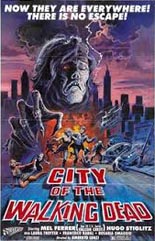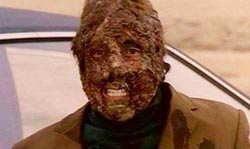
 When Danny Boyle’s 28 Days Later … premiered in 2002, nearly everyone reacted to its fast-moving zombies as if the director were the concept’s inventor. Wrong! Others had pulled that trick long before, including Umberto Lenzi (Ghosthouse) in the pasta-puker Nightmare City.
When Danny Boyle’s 28 Days Later … premiered in 2002, nearly everyone reacted to its fast-moving zombies as if the director were the concept’s inventor. Wrong! Others had pulled that trick long before, including Umberto Lenzi (Ghosthouse) in the pasta-puker Nightmare City.
Rendered Superman-strong by a radioactive spill at a nuclear plant, Lenzi’s zombies move quick as ever, travel in packs, have faces that resemble day-old guacamole dip, exhibit a vampiric thirst for blood and, post-feeding, often wipe their mouths on their sleeves. (“Tsk-tsk,” tsks etiquette queen Emily Post from the grave.) Some come armed with guns, but the majority prefers weapons of the stabby variety: knives, machetes, axes and even the occasional scythe — if it cuts, it makes the cut.
 Also known by the ho-hum title of City of the Walking Dead, Nightmare City is no great shakes in the plotting department; it’s one attack right after the other. What separates it from so many similar pics of the era is Lenzi’s staging of said attacks in unusual places, starting with an airport-runway bloodbath witnessed by our TV-reporter protagonist (Hugo Stiglitz, Survive!). From there, the undead:
Also known by the ho-hum title of City of the Walking Dead, Nightmare City is no great shakes in the plotting department; it’s one attack right after the other. What separates it from so many similar pics of the era is Lenzi’s staging of said attacks in unusual places, starting with an airport-runway bloodbath witnessed by our TV-reporter protagonist (Hugo Stiglitz, Survive!). From there, the undead:
• interrupt a live broadcast of a disco/aerobics show, wherein one spandex-clad dancer undergoes an impromptu mastectomy;
• commit a siege on a hospital, where the reporter’s wife (Laura Trotter, Miami Golem) works as a doctor and one zombie sucks on a bottle of platelets as a baby would to Mom’s nipple; and
• crash an amusement park (Six Flags Over Apocalypse?), where a body drop from atop a coaster track is one of the film’s lowbrow highlights.
As with other entries in the Italian zombie subgenre, gore is the score here. Many a head is blown off, many more throats and/or torsos are slit, but of particularly gruesome note is a female character’s eyeball removal. Only the peeper-meets-splinter scene in Lucio Fulci’s epic Zombie the year prior qualifies as more upsetting. —Rod Lott
